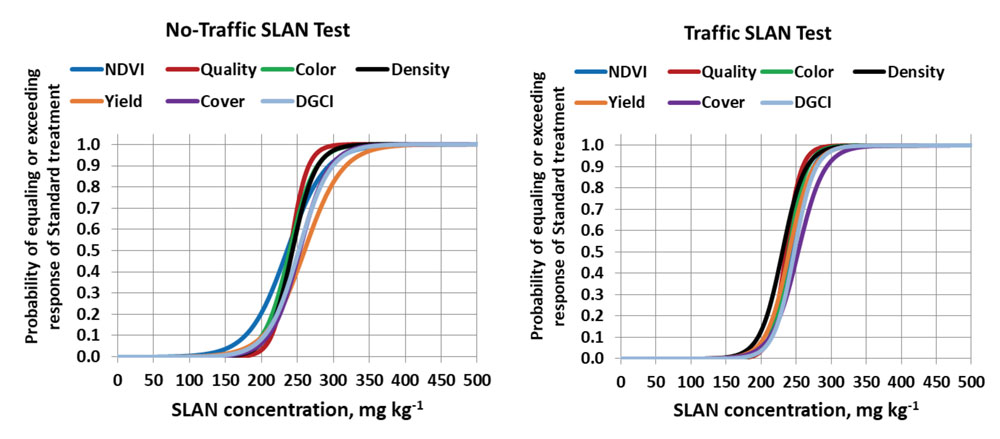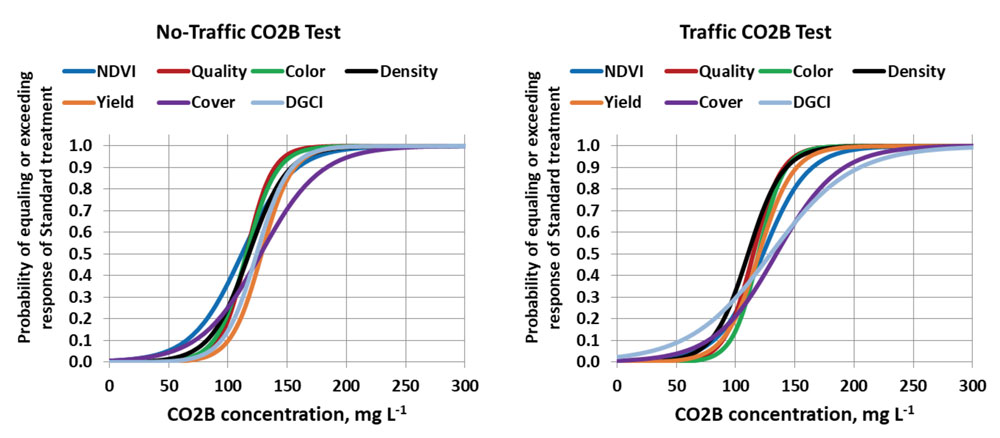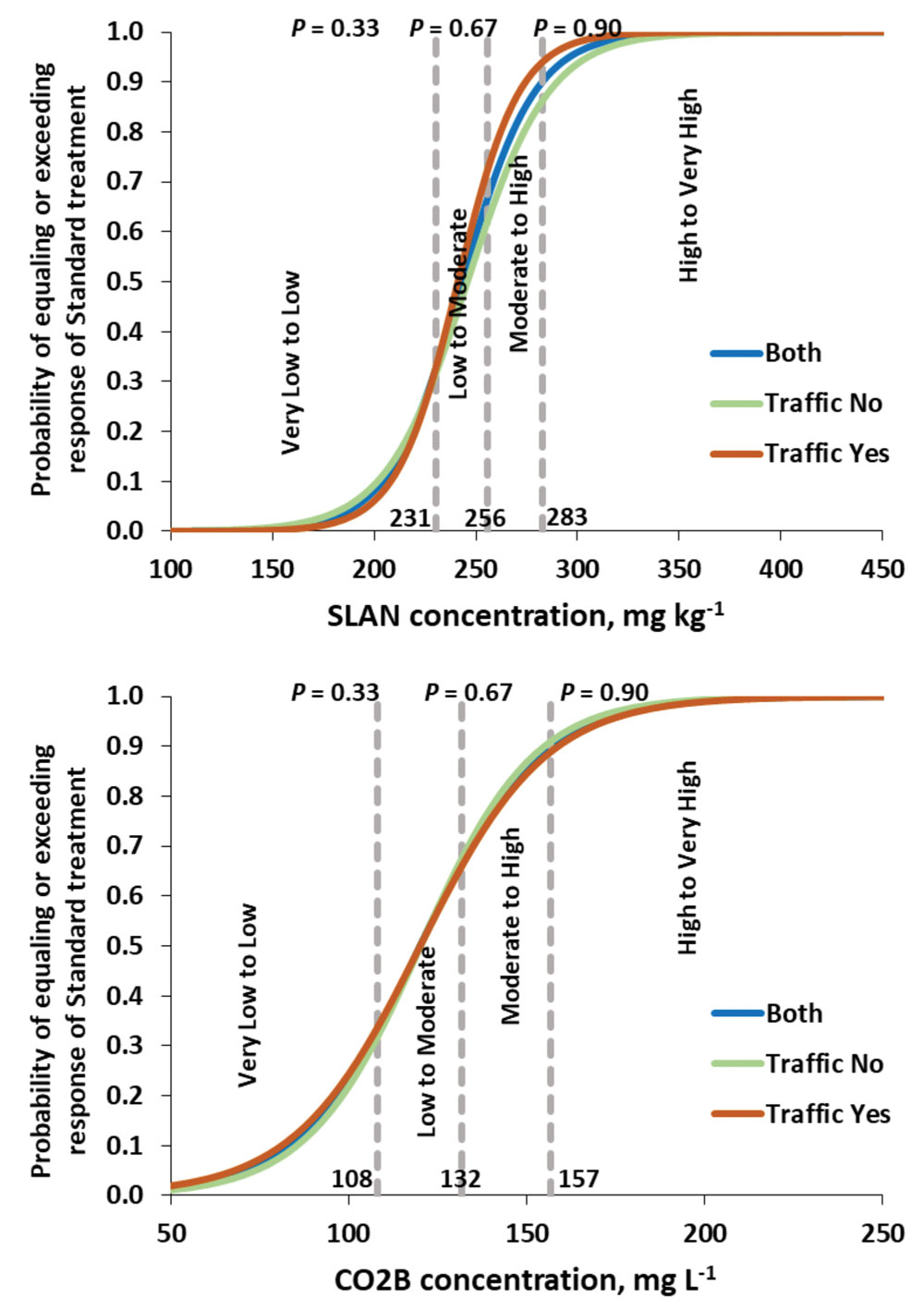A look at new soil tests that examine fairway responsiveness to nitrogen fertilization
 The ability to predict the nitrogen (N) mineralization potential of any turfgrass site and its expected response to N fertilization would be a valuable tool in nutrient management. Turfgrass soils often accumulate organic matter over time, increasing their mineralization potential. However, assessing this potential is not routine due to the lack of mineralization tests offered by many labs, the cost of the tests and the long-term requirements (weeks to months) of these tests for reliable results.
The ability to predict the nitrogen (N) mineralization potential of any turfgrass site and its expected response to N fertilization would be a valuable tool in nutrient management. Turfgrass soils often accumulate organic matter over time, increasing their mineralization potential. However, assessing this potential is not routine due to the lack of mineralization tests offered by many labs, the cost of the tests and the long-term requirements (weeks to months) of these tests for reliable results.
Solvita and Woods End Laboratories offer two tests recently developed to rapidly measure the biologically-active carbon (C) and N fractions in soil organic matter: the soil CO2-burst (CO2B) and soil labile amino nitrogen (SLAN) test kits.
These tests measure labile C and N fractions correlated to soil microbial activity. Therefore, the Solvita soil tests should be able to estimate the mineralization potential of turfgrass soils. An estimate of the mineralization potential should help guide N fertilization.
The objectives of this research were: 1) determine if there is a correlation between CO2B and SLAN tests and fairway creeping bentgrass quality and growth responses, and 2) if test results correlate to bentgrass fairway turf responses, then categorize the responsiveness to N fertilization as a function of Solvita soil test results with standard fertilizer treatment.
 Methods
Methods
In August 2017, we initiated the study site located in Storrs, Conn. We designed the experiment as a split-block design with traffic (yes or no) as the horizontal factor and compost (10 rates, in 0.25-lb. increments from 0 to 2.25 lbs. N per 1,000 ft. sq.) as the vertical factor with three replicates.
We incorporated compost into the 0 to 4-inch soil profile by rototilling before seeding. After compost incorporation, we seeded creeping bentgrass (‘13M’) into the study site and managed it as a fairway. During the bentgrass grow-in period during the late fall of 2017, we applied an organic fertilizer (Suståne All Natural 5-2-4) to the plots at the same N rates as the initial incorporated compost rates.
In addition to the organic treatments, we applied a standard fertilizer regime treatment with 0.2 to 0.25 pounds N per 1,000 ft. sq. approximately every 21 days as liquid urea. The fall of 2017 was an establishment period. The treatments and data collection implementation commenced in 2018 and continued in 2019, 2020, and 2021 with fall applications of Suståne organic fertilizer.
In 2021, we used a cart-traffic simulator to replicate traffic three times a week during the growing season. We collected bentgrass response measurements (NDVI, percent green cover, dark green color index [DGCI], visual quality, visual color and visual density) and soil samples monthly from May through November from each plot. We also collected clipping yield monthly from June through November for each plot. Using the Solvita CO2B and SLAN tests, we analyzed soil samples.
 We statistically analyzed data using analysis of variance to determine treatment effects (fertilizer rates, traffic and the fertilizer rate multiplied by traffic interaction) on the mean bentgrass quality and growth responses and soil CO2B and SLAN concentrations. We correlated mean fairway bentgrass responses to mean SLAN and CO2B concentrations within and across traffic treatments. We applied binary logistic regression to determine the probability of bentgrass fairway responses from the compost-organic fertilizer plots that would equal or exceed the responses from the standard N fertilization plots across the Solvita soil test values for each of the
We statistically analyzed data using analysis of variance to determine treatment effects (fertilizer rates, traffic and the fertilizer rate multiplied by traffic interaction) on the mean bentgrass quality and growth responses and soil CO2B and SLAN concentrations. We correlated mean fairway bentgrass responses to mean SLAN and CO2B concentrations within and across traffic treatments. We applied binary logistic regression to determine the probability of bentgrass fairway responses from the compost-organic fertilizer plots that would equal or exceed the responses from the standard N fertilization plots across the Solvita soil test values for each of the
traffic treatments.
2021 Results
Traffic effects were significant for NDVI, visual quality, color and density, percent green cover, DGCI and clipping yields (Table 1). Across these variables, the no-traffic treatment yield was significantly greater than trafficked plots. Fertilizer treatment effects were highly significant for all variables (Table 1). Averaged across traffic treatments, all responses were linear and significant in relation to fertilizer N rate (P < 0.001, data not shown).
Compared with the standard treatment, concentrations of SLAN were significantly lower at the non-fertilized 0 pounds N per 1,000 ft2 rate but significantly greater once the N rate reached ≥ 1.5 lbs. N per 1,000 ft. sq. from compost-organic fertilizer (Table 1).
Concentrations of CO2B were not significantly different from the standard at the non-fertilized 0 to 0.5 lbs. N per 1,000 ft. sq. compost-organic fertilizer rates but significantly greater than the standard treatment once the compost-organic fertilizer N rates reached ≥ 0.75 lbs. N per 1,000 ft. sq. (Table 1).
NDVI was significantly less than the standard treatment at 0 and 0.5 lbs. N per 1,000 ft. sq. compost-organic fertilizer rates but were significantly greater than the standard treatment once the compost-organic fertilizer N rates reached ≥ 1.5 lbs. N per 1,000 ft. sq. Response of DGCI from the standard treatment was greater than 0 and 0.5 lbs. N per 1,000 ft. sq. compost-organic fertilizer treatments but was significantly lower than the highest compost-organic fertilizer rate of 2.25 lbs. N per 1,000 ft. sq. (Table 1).
 Visual quality, color and density ratings were significantly lower than the standard treatments from compost-organic fertilizer rates of 0 to 0.5 lbs. N per 1,000 ft. sq. but were significantly higher at the highest compost-organic fertilizer rates of 2 and 2.25 lbs. N per 1,000 ft. sq. (Table 1).
Visual quality, color and density ratings were significantly lower than the standard treatments from compost-organic fertilizer rates of 0 to 0.5 lbs. N per 1,000 ft. sq. but were significantly higher at the highest compost-organic fertilizer rates of 2 and 2.25 lbs. N per 1,000 ft. sq. (Table 1).
The percent green cover of the standard treatment was significantly greater than the 0 to 0.5 lbs. N per 1,000 ft. sq. compost-organic fertilizer treatments but not different from compost-organic fertilizer rates ≥ 0.75 lbs. N per 1,000 ft. sq. The 0, 0.25, and 1 lb. N per 1,000 ft. sq. compost-organic fertilizer rates were significantly lower than the standard treatment for clippings yield. In contrast, the compost-organic fertilizer 2.25 lbs. N per 1,000 ft. sq. rate produced significantly greater clipping yields than the standard treatment (Table 1).
 Correlations between fairway bentgrass compost-organic fertilizer responses in relation to SLAN and CO2B concentrations were highly significant with high r values across the traffic treatments (SLAN r = 0.727 to 0.904; CO2B r = 0.620 to 0.914) (Table 2). There was no significant difference in r values between traffic and non-traffic treatments for SLAN concentrations and from all but one variable (visual density) for CO2B (Table 2).
Correlations between fairway bentgrass compost-organic fertilizer responses in relation to SLAN and CO2B concentrations were highly significant with high r values across the traffic treatments (SLAN r = 0.727 to 0.904; CO2B r = 0.620 to 0.914) (Table 2). There was no significant difference in r values between traffic and non-traffic treatments for SLAN concentrations and from all but one variable (visual density) for CO2B (Table 2).
Since there were strong correlations between Solvita soil test concentrations and fairway creeping bentgrass responses, binary logistic regression was applied to determine the probability of compost-organic fertilizer plot responses that were equal to or greater than the response of the standard fertilizer treatment with respect to the SLAN and CO2B concentrations. We show probability curves in Figures 1 and 2 for traffic and no-traffic plots.
The probability curve of SLAN concentrations for all variables in both no-traffic and traffic treatments was modeled relatively well. When we combined all variables, there would be a ≥ 67 percent chance that fairway bentgrass responses would equal or exceed the responses of the standard fertilizer treatment when SLAN concentrations were ≥ 260 and ≥ 252 mg kg-1 for non-trafficked and trafficked plots, respectively (Table 3).
The probability curves for CO2B concentrations for all variables in both no-traffic and traffic treatments were modeled relatively well. When we combined all variables, there would be a ≥ 67 percent chance that fairway bentgrass responses would equal or exceed the responses of the standard fertilizer treatment when SLAN concentrations were ≥ 131 and ≥ 133 mg kg-1 for non-trafficked and trafficked plots, respectively (Table 3).
Future Expectations
With each year of treatment imposition, we observe better correlations and model fits of the data. We attribute this to more mineralization of the compost and organic fertilizer additions. The data suggest the production of reliable tables of SLAN and CO2B concentrations and associated probabilities of responses equal to or exceeding the response of the standard fertilizer treatment of 0.2 to 0.25 lbs. N 1,000 ft. sq. applied approximately every 21 days for our soils and climate conditions. This could assist the superintendent in guiding fertilization based on their risk tolerance (See example in Tables 4 and 5 and Figure 3).

(Fig. 1) Compost-organic fertilizer probability curves of equaling or exceeding the NDVI, DGCI, visual color, visual color, visual density, percent green cover, and clippings yield response of the standard fertilizer treatment (approximately 0.2 lbs N per 1,000 ft2 every 21 days) relative to the Solvita SLAN concentrations for the no-traffic and traffic plots (2021 results pooled across all sampling dates).
The goal of using the Solvita tests to guide N fertilization for turfgrasses would be to recommend a specific amount of N needed for the optimum response for any specific SLAN or CO2B concentration. Following the concepts presented in Tables 4 and 5 and Figure 3, we could suggest fairway creeping bentgrass soils with:
- SLAN or CO2B concentrations that fall below the P = 0.33 cutoff receive the full recommended N rate,
- SLAN or CO2B concentrations that fall between the P = 0.33 and the P = 0.67 cutoffs receive ⅔ to ½ of the recommended N rate,
- SLAN or CO2B concentrations that fall between the P = 0.67 and the P = 0.90 cutoffs receive ½ to ⅓ of the recommended N rate, and
- SLAN or CO2B concentrations above the P = 0.90 cutoff receive little to no additional N fertilization.

(Fig 2) Compost-organic fertilizer probability curves of equaling or exceeding the NDVI, DGCI, visual color, visual color, visual density, percent green cover, and clippings yield response of the standard fertilizer treatment (approximately 0.2 lbs N per 1,000 ft2 every 21 days) in relation to the Solvita CO2B concentrations for the no-traffic and traffic plots (2021 results pooled across all sampling dates).

(Fig 3) Compost-organic fertilizer probability curve representing all variables combined for both traffic treatments and categories of fairway creeping bentgrass responses that would be equal to or greater than the responses obtained from the standard fertilizer treatment in relation to Solvita SLAN and CO2B concentrations. The gray vertical lines indicate P values of 0.33, 0.67, and 0.90 obtained from the equations used for values in Tables 4 and 5 (2021 results).
The example above would assume that optimum conditions for mineralization would be present across the growing season. Another approach to using the P values to guide N fertilization is for superintendents to apply (1 – P) × the full rate of N fertilization, where P is the probability of equaling or exceeding the standard fertilizer treatment response based on the SLAN or CO2B concentration (See example presented in Tables 4 and 5).
The results from 2021 suggest that the Solvita soil test results correlate well to fairway creeping bentgrass responses. We have had three years of consistently strong data to show the potential of these new tests in predicting fairway mineralization and use in guiding N fertilization.
Suppose this holds across different years, soils, and climates. In that case, golf course superintendents will have new tools to easily and quickly assess the mineralization potential of any fairway on their course. These tests will be site-specific and give the superintendent objective guidance for N fertilization.
The value of using the Solvita soil tests also would be seen in fairway areas where mineralization potential is low, and where they could benefit from an optimal N fertilizer rate. An additional advantage of the Solvita soil tests is that they could be conducted on-site by the superintendent with a full test kit, if desired, without the need to send samples to a laboratory.












